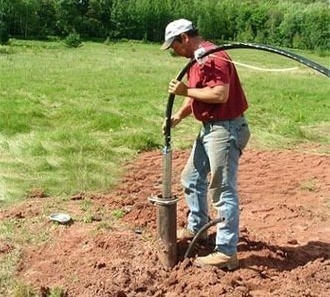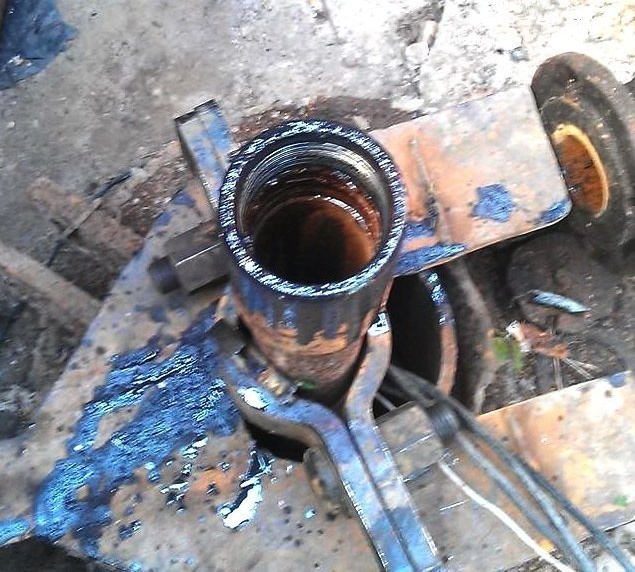How to shake a well after drilling: proper pumping technology + common mistakes
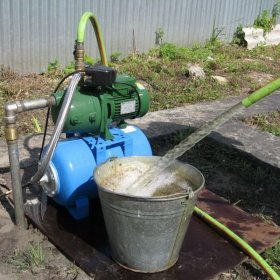
A well is an excellent solution for autonomous water supply of one’s own home or cottage. Work on its arrangement will require qualifications and special knowledge, therefore they are often assigned to drilling specialists. However, in any case, work was performed using special equipment or almost manually, at the end they will need to solve the problem of how to pump the well. But these actions, each owner of the structure will be able to perform independently.
What is buildup and why is it needed?
The buildup is called the process of cleaning the well after drilling. Contrary to expectations, the water that first appears in the pipe is unsuitable for drinking, cloudy and needs to be cleaned. If no action is taken, it will remain such, the well will eventually become silted up and stop working.
Silting is an absolutely natural process. It does not stop for a minute due to the fact that the aquifer contains not only relatively large stones and sand, but also a myriad of tiny particles that are completely elusive for filters. They easily bypass the gravel and strainer, and then settle to the bottom of the well, "eating" its depth and seriously reducing productivity.
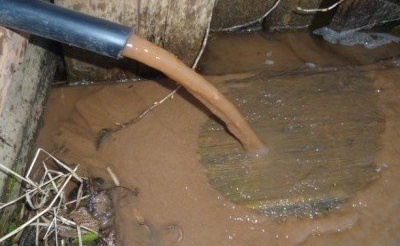
At the very beginning of the buildup, the pump raises a suspension of water, fine sand and clay to the surface
Professionals emphasize that competent pumping of a well after drilling allows you to remove all small particles from the aquifer located directly near the pipe. After the start of the process, a very muddy liquid is supplied from the well. During a gradual wash, it brightens and at the end becomes crystal clear. The duration of the well buildup depends on the type of soil and can last from 12 hours for shallow wells made in sand to several weeks, if not months, for deep structures drilled in limestone or clay.
Owners of sites located on alumina are interested in how to properly pump a well through clay. This is a rather long process, due to the fact that during the course of drilling and subsequent intensive washing, a muddy clay solution is actively formed. It penetrates deep into aquifers and is extremely difficult to wash. This can take weeks or even months. During this time, a very large amount of water will be pumped out, in especially difficult cases, even more than half a thousand cubic meters, and the cleaning process will be successfully completed.
Description of the technology of work
Actually pumping a well is an ordinary pumping of water. However, there are several aspects that need special attention.
The right pump choice
Even if the owner has prepared a powerful device for supplying water, do not lower it into the well.Experience shows that high-quality expensive equipment will come in handy later for pumping clean water. Whereas it is advisable to purchase an inexpensive submersible pump especially for the buildup process. Most likely, he will regularly fail, pumping a muddy suspension, but his business will be completed. At the same time, the more expensive “permanent” option will remain unscathed and will be able to work perfectly in clean water. Another nuance: the “temporary” pump should be a submersible centrifugal pump, since the vibration models simply cannot cope with such a load.
Pump suspension
When thinking about how to pump a well after drilling, it is worth paying special attention to the height of the pump. It should be located close to the bottom line of the well, 70-80 cm above its mark, almost at the same level with the gravel filter. In this case, the sludge will be captured, and actively withdrawn. So that the pump can work in this mode for as long as possible, it must be periodically stopped, removed and washed, passing clean water through it.
Ramp up time
It is difficult to say right away exactly how many hours or days it will take to pump a well.
The process should continue until clean water appears. The intensity of the sway directly affects the result. The more water is pumped out, the more sand and other small particles go with it. Coarse sand that has not passed through the filter settles to the bottom, forming an additional filter layer.
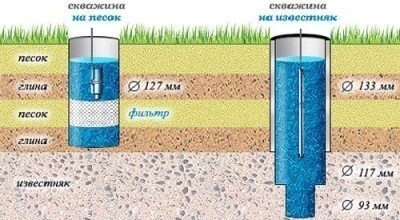
The duration of the buildup process depends on the composition of the soil on which the well is equipped
Experts say that to completely clean the well, it is necessary to pump out dozens of tons of water from it. On average, with a building depth of 50 to 500 m, the process should go on for at least 48 hours, with less depth, respectively, less.
Mistakes to Avoid
When the buildup behavior of a new well occurs errors that violate the cleaning process. The most typical of them include:
- Suspended pump too high. It should not be placed close to the surface of the water. Otherwise, the use of equipment will be useless: it will not be able to capture small particles, which are most in the bottom of the well. In this case, despite the ongoing swinging measures, the well will quickly become silted up and stop supplying water.
- Pump lowered too low. An in-depth device cannot function properly. It will very quickly become suspended and stop. In addition, the pump may be buried in the sludge. An apparatus pulled into the ground is very difficult to remove to the surface.
Illiterate water diversion. Pumped out dirty water should be diverted as far as possible. Otherwise, it can again fall into the well and then the buildup process can last almost indefinitely.
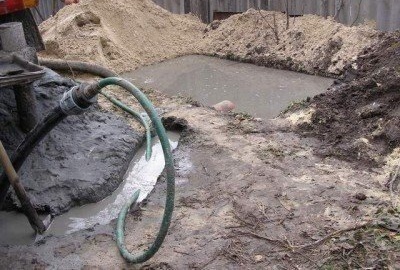
When swinging, it is important to divert contaminated water as far as possible, otherwise it will return to the well and the process will continue indefinitely
- Running the pump on an insufficiently strong cord that comes with it. It’s better not to. The device may get stuck in the well or be dragged into the sludge. In this case, it is unlikely to be pulled by the cord. It is worthwhile to purchase a durable thin cable and use it to lower the pump for swinging.
Ways to combat siltation
The water in the well will always be clear and clean, if from time to time to carry out preventive work.
Each owner of the structure needs to know how to pump the well to prevent re-silting. For this, during periods when water intake is reduced, the pump should be switched on regularly for two to three hours. If, nevertheless, despite all efforts, a sludge plug has formed at the bottom, you can try to wash it. A hose is lowered into the well before the pump, through which pure water is supplied under pressure.It will wash out unwanted bottom sediments, rise up the annulus and splash out of the well. The procedure should be carried out until, together with water, gravel from the bottom filter begins to come to the surface. Next, carry out the usual buildup.
The well is fairly easy to operate. It is important to correctly conduct drilling operations and equip a structure that subsequently does not cause much trouble. It is very important to know how to properly swing the well so that it gives a large amount of crystal clear water. High-quality rocking work is the key to a long and uninterrupted operation of the structure.

